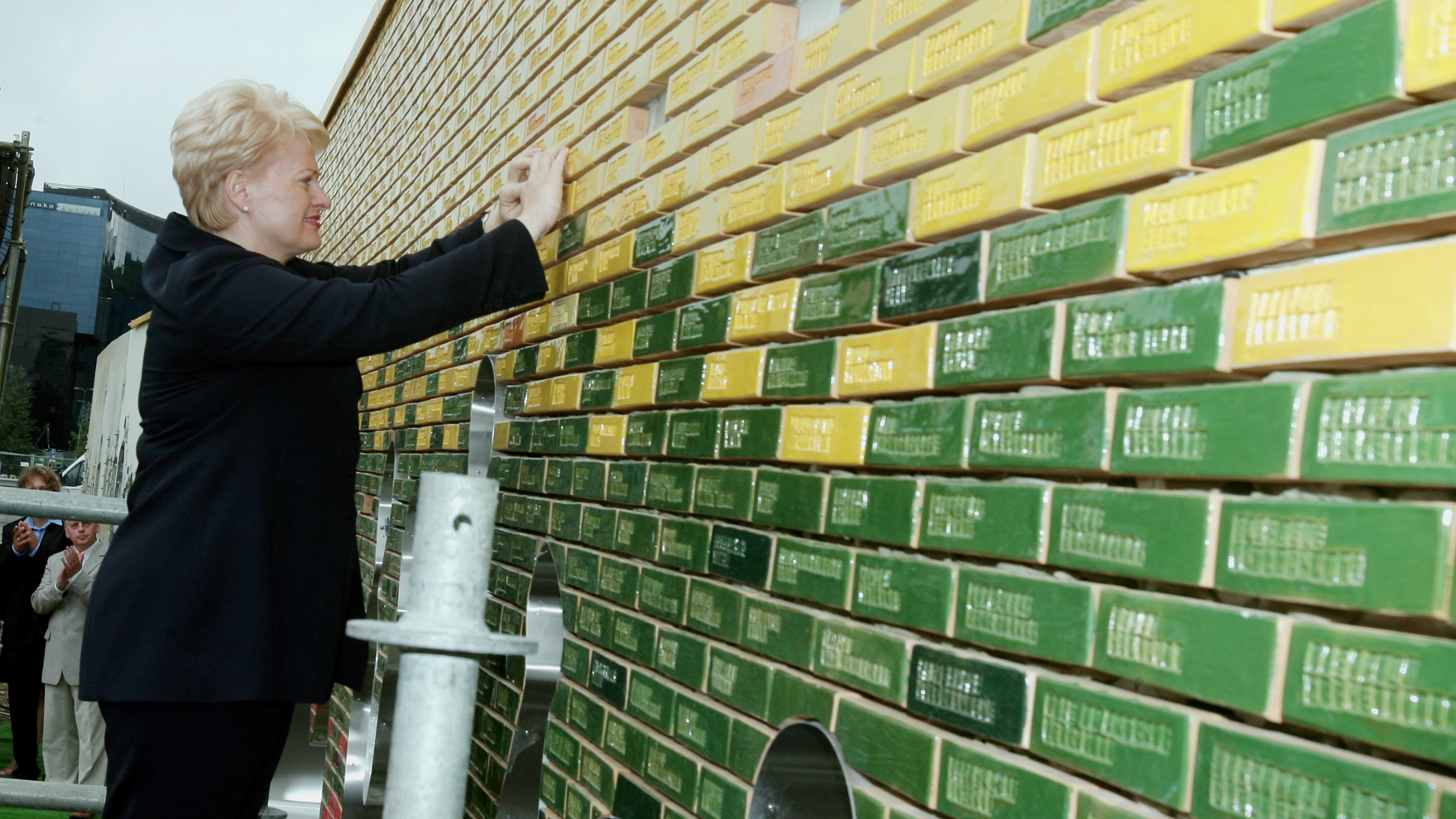
President Dalia Grybauskaitė puts a brick into Vilnius' Baltic Way monument during the unveiling ceremony on Monday. Photo by the Office of the President of the Republic of Lithuania.
VILNIUS — Twenty-one years after the Baltic Way united Estonia, Latvia and Lithuania with a human chain to protest against the Soviet occupation, a new monument commemorating the event was unveiled in Vilnius.
On Monday President Dalia Grybauskaitė, Prime Minister Andrius Kubilius, Speaker of the Seimas Irena Degutienė, former President Valdas Adamkus and Sąjūdis leader and European Parliament member Vytautas Landsbergis attended the unveiling ceremony for the monument, a brick wall painted with the colors of the Lithuanian flag and silhouettes of people cut out next to Vilnius Pedagogical University.
“Baltic Way — a work of the people, the Baltic Way — a people of hope and faith, the Baltic Way — a symbol of freedom and unity, the Baltic Way — a future of our nation,” Grybauskaitė said at the ceremony.
Although representatives of the Latvian and Estonian governments were present, the monument focuses on the Lithuanian contribution to one-third of the Baltic Way human chain. The project is being partly funded by the reservation of the bricks, which people can pay 25-50 litai (€7.25-€14.50) for to get their name on the wall as a contributor. Already 97 percent of the bricks are reserved.
“This sculpture, just like the ‘Baltic Way’ created unanimously by the Lithuanian people 21 years ago, is a collective creation – everyone can contribute to the project and get a special brick which will be put in the sculpture. Each brick will be the in the colors of the Lithuanian flag and the name of the person who has contributed to the sculpture will be stamped on each brick,” a press release from the project coordinators says.
Why the Baltic Way is important
On August 23, 1989 some 2 million residents across the Baltic states joined hands as part of a non-violent protest action calling for restoration of independence for the three nations. Called the Baltic Way, it was a show of solidarity against years of occupation by the Soviet Union and was organized and coordinated by the pro-independence movements in all three countries.
Baltic residents formed a 600 km long human chain that stretched from Toompea in Tallinn to Cathedral Square in Vilnius, crossing Riga and the Daugava River en-route.
The protest took place on the fiftieth anniversary of the signing of the Molotov-Ribbentrop pact, which divided Eastern Europe into spheres of influence of the U.S.S.R and Nazi Germany and lead to World War II and the occupation of the three Baltic states.
Following the demonstration the Soviet Union declared the secret protocols null and void. Six months later, Lithuania became the first Soviet republic to declare independence from Moscow and Latvia and Estonia soon followed suit.
For more information about the monument, visit its website.
This article is free to view. To read Baltic Reports’ subscription-only articles, click here.













A serious omission, citing the Molotov-Ribbentropp is not to remember that Poland in the autumn of 1939 was divided not only between Germany and the USSR, but also from Lithuania. The Government of Kaunas, with the approval of Hitler and Stalin, it took possession of Wilno, drove away the Polish population, changed the name of the city into Vilnius and it moved the capital there. Lithuania never returned to Poland this territorial advantage. In 1945, thanks to Stalin, Soviet Lithuania also took Memel from Germany, drove out the German population and changed the name of the city into Klaipeda. These favors are obtained thanks to Stalin’s skeleton in the closet of Lithuania, improperly remembered as a victim instead of collaborationist of the USSR.
2 Lorenzo: You failed to mention that Vilnius, the historical Lithuanian capital and never a city of Poland, was stolen from Lithuania by Poland 20 years before WW2, with Polish consequently driving out Lithuanian population (my own grand-grandparents were given 1 hour to empty the house to polish settlers). Lithuania regained Vilnius just before WW2, but had to pay it’s freedom for it, and got back only 1/3 of the Polish-occupied area- the rest Stalin incorporated into Belarus. You should be ashamed to speak about this matter, as you surely know little of cruelties suffered by Lithuania from our dear neighbours- Poland and Stalinist Russia. And Klaipėda- it is historically german, but was part of Lithuania in between the wars- and taken from Lithuania by Hitler just before WW2.
@neblogai, I am sure you also acknowledge the suffering inflicted by Lithuanians on their fellow citizens and neighbours during the Holocaust.